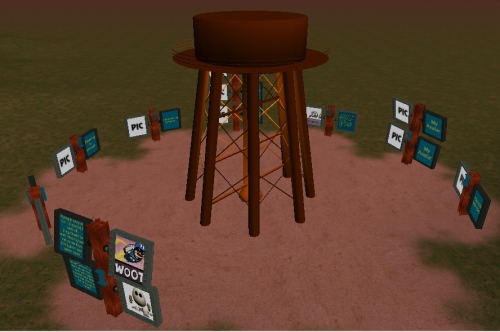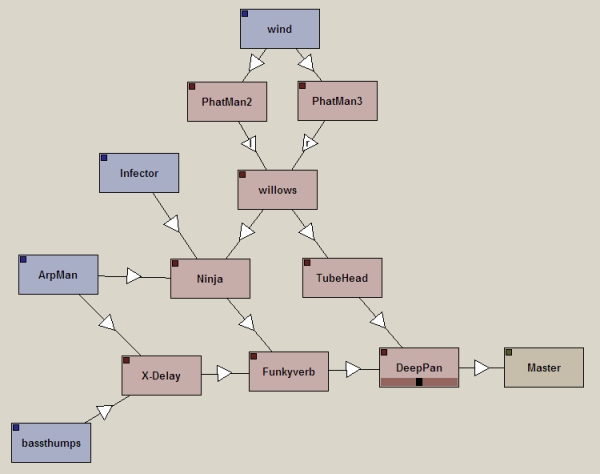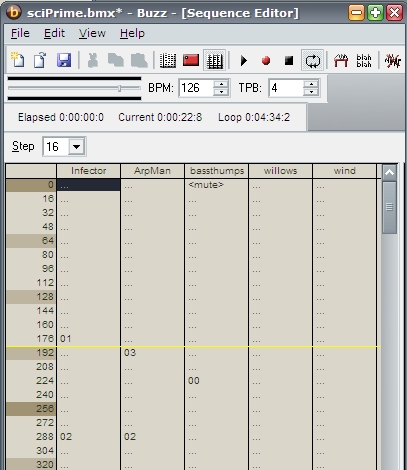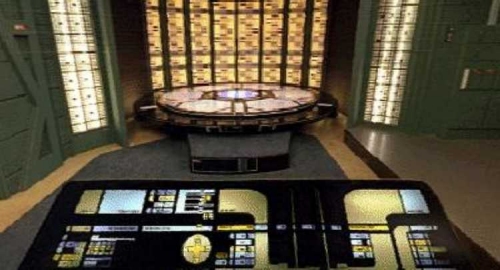n00bs, gotta love ’em
… you land on this foreign planet, right, and you are the visitor, so what do you need to know?
That question is an interesting one – in a 3D world there is LOTS that you can know but what do you NEED to know.
context: punters are students years p-7, and their teachers, and some mentors.
I thought that concentrating on CITIZEN RIGHTS was a good starter – privacy, save place to learn etc, all good up-front.
Then come CITIZEN RESPONSIBILITIES – a little more fuzzy, but things like don’t break what is not yours, do not offend, clean up after you etc.
I figure if you place this stuff where they HAVE to walk past, at least initially, there is a chance they might read it – the wording and format … that is the part of the task that is like nailing jelly to a tree.
If I use “sign” objects, then there is a limit to the number of characters I can display, and I have nearly no control over the format (font size, wrapping, text effects), so will need to seek advice higher re visual styling and consistence, and I guess the actual wording. The “picture” object lets me embed an image version of the wording (that takes time, I prepared one earlier) which I think is the right way to go – styling and someone with the actual time to do this right now … umm, help.
I went for an industrial feel – the whole complex is old, corroded and not shiny so I think it fits. It still looks a bit spartan, yet to embellish and clutter, concentrating on the infrastructure first and will busy it up later. I used rusty “I” beams, thought they looked ok and let me expand when I need to, just get out the welder and we are away.
I included the obligatory “work in progress” – in much the same way a website is NEVER complete, I would be astounded if this world ever is finished – people long after I am gone will be adding/modifying/re-working I hope.
I included reference to a “basic orientation” or O-ZONE interestingly clustered around the base of the ozone tank, well I thought it was clever, and began to imagine what are the basic skills required to just drive the world – not building, that will be handled elsewhere, just the beginners guide to Activeworld use.
Moving; talking and more generally communicating; playing with your avatar; manipulating objects; remembering places; and taking pictures were what I first concentrated on – what have I missed?
It needs to be clear, concise, written in a language that can be understood by emerging literacies, it should where possible have companion illustrations, they should be fun, informative, simple but illustrative – all in all, quite a task.
I will have to ask for help I think as I am flat out designing and making the buildings – the level of accompanying documentation and illustration is important and will couch the activities that users involve themselves in when we are in production.
So … HOMEWORK: what do nOObs need to know? How do we tell them? What level of explanation is appropriate as an intro – can the skills be categorised? What sequence? How should they be displayed? All interesting questions dear reader – want to contribute to the discussion?
Aural wallpaper
now sight is part of the equation when creating an environment – sound is another. I got thinking what would trigger a feeling of “not being in Kansas anymore” and reminded myself of the wonderful, convincing worlds created in my favourite sci fi movies.
tension, sense of place, disconnection with the here and now and replacement of the there and then can be achieved by an authentic experience, so I had a go at creating some music.
Now this is not new for me, but it has been a while. So I fired up my favourite modular digital synthesiser (Buzz), constructed a noise-making machine, added effects
and then wrote some patterns, plugged these into a sequence
and, after a little tweaking, recorded to CD-quality WAV about 5 minutes of atmospheric bubbling, throbbing and other spaced sounds. I ripped it to MP3, tagged it, uploaded it to the public object path of our virtual world and then scripted an object to play the sound on create and presto .. instant atmosphere.
Link to the original spacescape – what do you think? Does it enhance or annoy? I quite like it. It greets you at the initial world connect point. I think I shall add machine drones and other atmospherics strategically elsewhere also.
Across the universe
So it is now time to consider the multiverse, or more particular the universe as it is defined by this new world…

Now it seems that Activeworlds offers licenses that enable a number of different configurations – “World” [hosted or not] which are a separate private place up to “Universe” which allows multiple worlds, remote hosting. We have chosen a U3000 license – this means [correct me if I am wrong please] multiple worlds, total of 9,000,000 square meters [that seems a lot right now] and up to 500 users online simultaneously.
This ties in with what I had envisaged: a “homeworld” of sorts, which I am terming “Offworld Homebase” and a cluster of related, connected worlds that you can teleport between. It allows a certain level of granularity that will allow other projects and space to grow in the future, but is suitable scalable as a model that it should suit our purposes nicely.
Users connect, initially, to Offworld Homebase as the initial login/connection point, and then from there travel to their chosen location if necessary. This level of abstraction could be useful, as the connection point is clearly not here – as in it is clearly on a different planet, so we have distanced ourself in the first stage. We might teleport to an “earth-like” place, but the distinction between reality and virtual world is a natural one. users should more readily accept the look and feel of the place if they know it is not trying to fake here, if that makes sense.
Homebase should have orientation, general skills, meeting and collaboration tools and places to select context, might have habitation and recreation but should also provide jump-points [a teleportery] to places of interest. These would include:
- Related learning objects – we can link to existing learning objects that can be used in the in-world browser – a lush and huge collection of existing multi-disciplinary interactive objects that are well integrated into existing curriculum
- Science Outstation – this could be on the same planet, or a different one but would provide additional bridges to sims that users could visit, explore, plan and create solutions for problems they perceive there
- Sandbox world – the builder’s play pen – somewhere people could go and learn to build – a mixture of tutorials and resources to allow citizens to explore construction options. It should include links of the web catalog of objects in the public object path.
- …other stuff [What do you reckon? What is IMPORTANT in the initial build? Is there anyone reading this?]
The design of Offword Homebase then becomes the next thing. I rather like the whole “cluster of domes” in a crater idea, each linked to each via passageways – if well thought out and modular this could work well, the layout of domes is an aesthetic challenge, but there are a number of visual aids, namely molecule pictures and a style of Indigenous Dot painting that symbolises “waterholes” that could be useful [and also provide useful graphical motif for later design work, textures and finesse]

I am still to find out the distance that chat drops out – if we have meeting rooms, chat in that room should not spill out into adjacent areas. Looking at big picture first, then will focus on minutiae when general layout is decided. Using design tenets, odd numbers usually look better than even numbers, and we can have domes of various sizes, orientations and materials.
Networks …

The People are the Network
I am as guilty of it as the rest of you: beavering away in isolation assuming that uninterrupted attention and personal research would be sufficient to get a handle on something new when … there are people who know stuff that you could ask, expertise that you can draw on. Yeah, I know, a “duh!” moment, but hey, it took me a while to re-realise this, my brain is in holiday mode and I am sporting about a week and a half’s beardy wierdy growth [should do something about the “bad santa” look actually].
The Internet is an amazing thing [will these revelations and original incites never cease I hear you face-palm], it provides a conduit through which people can reach out and share – not a Google “CDROM in the sky” sort of sharing [which is just really glorified “taking”] but providing a sounding board to bounce ideas off, offering fresh perspectives and re-directing questions to other contacts. It took a late night conversation [for me] with Lindy [early morning of previous day for her – she is on the other side of the planet physically and there is this pesky thing called linear time and an even more perplexing international date line thing that always messes with my head] to help me realise this again. Wow that was a convoluted sentence – English is teh sex!
The “virtual world community” is vast, and it makes sense to talk to other people about what they are doing, how they are doing it, why they are bothering to do it at all [shits and giggles are all very well – sheesh, I have built my life out of them; but work/play time needs to be value-added sometimes, right?], what others thought about it, how others used it and how effectively it did it’s job. More interestingly, was it done well enough for “emergent” behaviours to occur – you know, people/things using the stuff in ways that are perfectly valid, interesting, valuable but … unexpected or not specifically planned for – the mark of true success for me.
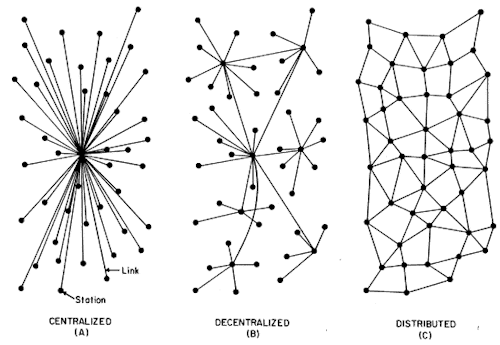
Modes of Connection
How you connect is a product of a few things – the situation you find yourself in, your social ability [those who have taken any real time to get to know me would realise I am actually a bit of an agorophobe, I get wierded out by people … so naturally I took on a career as a teacher, but I digress] and assuming that one pattern persists for any extended period of time is not necessarily correct either – a little from column A, little from column B and a little from column C at times [see how I seamlessly interwove a rambling with an included and shamelessly stolen image from Google?].
The biggest problem with relying on model A all the time is that the epicentre holds it all together. If I have learned nothing else from being employed, I have learned that NO ONE is indispensable. Model A works if the linchpin is dynamic and active, in touch with all the other stations and cognoscente of what they are doing but able to delegate responsibility to them – they hold the pieces and the linchpin holds the big picture.
Model B is more closely what usually happens – people form clusters of interest and activity and the relationships between puddles of activity need mediation to ensure all are on the same page. It is effective because the puddles form out of common purpose, vision or association. It fails when the puddles lose touch with each other or lack a basic understanding of what the others are doing – this can lead to duplication of effort and misundertsanding, power play and other politics [did I mention I am so not interested in politics, just putting that out there].
Model C “should” work, but is rarely if ever used in human society and I wonder why. Yeah, sure, organisationally it is fraught with issues around who is doing what, when, with what, why and when they will be done, but a distributed model is emerging from the murky ether of computer networks as the “smarter” way to get something big and complicated done effectively.
I attended a Secondlife presentation this morning on using GIS data [off topic? I no longer know, sorry], satellite imagery and other geo-spatial data sets are being harnessed to dynamically and [at least in the final phase] automatically generate faithful scale models of the real world in a virtual one – the demos were truly impressive as the data sets modellers can draw on for many parts of the planet are so rich and varied but wow, what an idea. I could see augmented reality products, architectural sims for planning permission, traffic flow sims etc that _could_ be where this was heading but the commercial applications were front and centre, sadly. What amused me the most [and it was naughty of me, and so off topic again, but you get that] was that the sims produced by this automated data acquisition were 1/3 size, so the presenters avatar was 1/3 size also – he presented in-world on a highchair specially built for him [presumably so as not to look like a highchair but failing miserably] as a very short munchkin [by established munchkin standards -yes I Googled that also].
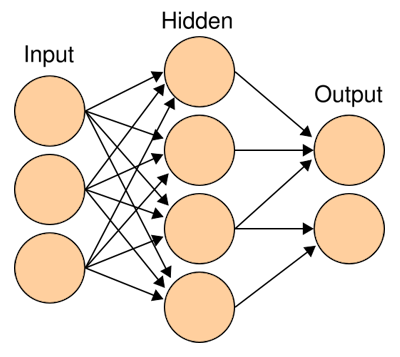
The Hidden Layer
Before I go on, I stole another image [thank you Google] that illustrates an artificial neural network – well one flavour of them called a back-error-propagation neural net. It exemplifies a connection pattern that I suspect is closer to what actually happens in many projects – there is INPUT, often at a high/conceptual level, a bunch of geeks then beaver away HIDDEN [well, in truth, in the background, but this is a metaphor so you can cut me some slack] and make something that is the OUTPUT that is either celebrated or derided. It is a long way from the DESIGN-DEVELOP-EVALUATE process that has built-in feedback backwards and forwards throughout the process, but I digress. Thought I would include it anyways because it was neat.
I skyped [is that a new iVerb? like “googled”, “blogged” …] with Bron about virtual world projects, in particular Activeworld projects and got some great advice, pointers to people, ideas for cross-pollination of projects and some insight into in-school resistance that any project will have to face. She reminded me [thanks again Bron] that the power of people and purpose is never stronger than when developing something new [particularly when there are people who have been there, done that, with that for a long while], and that the NEW should be considered a COMPANION for what is already there – building BRIDGES is much more constructivist [and conducive to skills transference, adoption, peace, harmony and the American way] than erecting FENCES. We also agreed that even the flashiest, twirliest new thing is a hopeless waste of time if there is not sound PEDAGOGY, and it is not embedded in quality CURRICULA and implemented by enthusiastic and capable MENTORS.
Much to follow up on, personal learning networks can be transformational, if you let them be. I also scored a guest account in Quest Atlantis [an ActiveWorld I first entered as part of the pilot years back, with Bron] and am interested in world feel, use of objects, layout and interface affordances. Some more play ahead I hope.
Metaphorically…
…so I am painting a room in our house, right, and am being organised about it [I have painted a bit, so know my way around the ‘no more gaps’] and a metaphor struck me, bear with me, it may be either instructive or end up meaningless dribble…
The right tools for the job
It makes perfect sense in retrospect – some jobs are a breeze and others are a trial from go to whoa. All to often it is because of the tools involved – both the implements you use to perform the task, and the personnel that are involved [not branding people tools, but you need to stay with me on this]. I used to have a hand drill, drilling holes was always pained and I always did a half-assed job. I bought an impact drill and suddenly drilly-type jobs were easy. I bought a “sash cutter” brush – a chisel pointed jobbie that makes cutting one colour paint neatly beside another easy and, hey presto, I have lovely edges to my cornices.
My point? Assemble the right tools for the task and the task is easier. This might mean installing the right software, sharpening a pencil instead of reaching for photoshop, bringing together a team that know stuff you do not or simply taking a water bottle with you so you can have a drink when you are thirsty. It is not rocket science, when someone points it out to you, until then, you wrestle, curse and retrospectively look back and think to yourself that you could have done that better.
Surface preparation
There is an old adage: Prior Preparation Prevents Piss Poor Performance – although an alliterative masterpiece, it turns out to be true. Returning to the painting metaphor: bogging, sanding and ensuring that the surfaces are in the best condition before you apply paint means the job is done better. In the real world, this suggests that finding out all you can about the thing you are trying to do pays in the long run. Skimming and only dealing with things on a surface level is a recipe for disaster. In a technical project dealing only at a surface level means that it takes nearly nothing for you to plunge out of your depth, flailing like a noob.
Understanding the nature of the platform and how one best works it is actually fairly important if you want to make real and sustained progress. This often necessitates play, screw-ups and research – all too often those in charge do not credit this as even part of the process, and that is a mistake. Acquiring new skills takes time, effort and a genuine desire to take on these skills – all else is window dressing. Again, this is not rocket surgery, well, it is not after you have had it pointed out to you by someone who knows what they are doing.
Technique
Most crafts [all skills that manifest in activity I am clumping together into the “craft” bucket, hope that is ok] have established conventions, ways of working and often associated ways of thinking. All too often the ways of working make sense and have arisen out of experience, working out the most effective way of arriving at a set goal. Experts know the techniques, novices wrestle until they discover them. When painting, for example, I have found out there are best ways of brush work [well, ways that let me control the application of paint with control and accuracy] that involve drawing the brush towards me rather than away – now it may well be that others work in different ways but I have found what works for me. I know how to load a roller so it does not drip, and how much of the wall I can cover before needing to re-load.
Development platforms all predicate ways of working but fine technique, producing digital products efficiently and effectively takes technique – sometimes that technique is common, sometimes it is platform specific – learning which is which is interesting but necessary.
The “Top Coat”
The quality of the final [or top] coat of paint is not so much about the quality of the final brushwork, but more about the quality of what is underneath. Sure, the fine detailing matters, but so does what has come before – quality from ground-up. No amount of re-touching will fix poorly filled crenulations, finesse is however important. The finishing touches can make or break the job – care and attention to detail are paramount, this involves standards.
When working in a virtual world, metaverse stuff is only important if the microcosms you create are detailed, believable and contextually relevant. Ensuring textures align, seams are tidy and object alignment matters. It is no surprise that imperfections stand out like the proverbial sore thumb. For an digital platform to be successful, it must allow the user to finesse, to fuss over the detail once the metatask is complete, there should be a rich collection of tools that can be precise and used with precision, accurate and used with accuracy. Now, in rocket science, the devil is in the detail [remember the Challenger disaster – so much undone by such trivial imperfection].
The Cleanup
Knowing when you are done is only part of the issue. Cleaning up the mess left in your wake as you move towards your goal state is one aspect, sitting back and admiring your handiwork the other. When sitting back on your laurels, good job well done … how do you know it was a good job, and more importantly, how do you know it is well done? If the walls look nice when the curtains go back up, when the electrical fixtures are screwed back on and the furniture re-positioned, if the room works as a room, it has been worth it, right?
When developing something for an audience, how do you determine it was successful. In the theatre, a round of applause is not always a measure [they could just be being polite, right, only to find yourself savaged by the critics in the morning newspapers]. How do we judge the success of our … thing…?
This is not a trivial question and, if anything, probably the crux of this post. Money runs out, politicians [or other public figures] trot out exemplars, papers are written, energy is expended, immigrants come and go – what will be the mark of success here?
I do not know, sorry. I have not got a clue. Really. But I am interested enough to find out. Are you?

